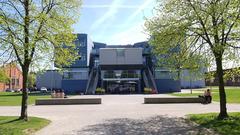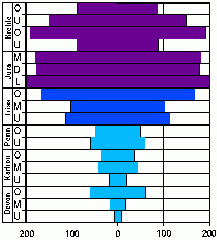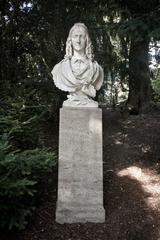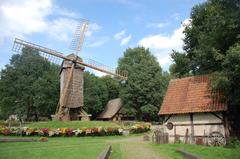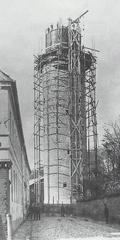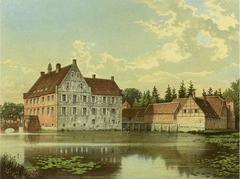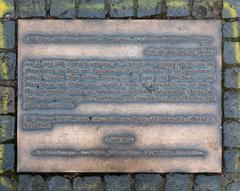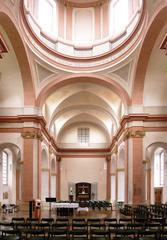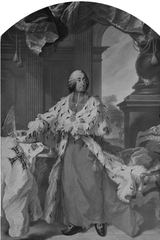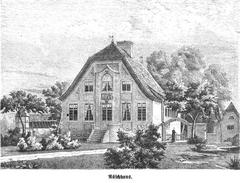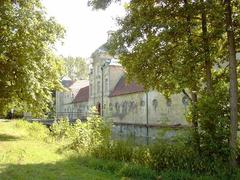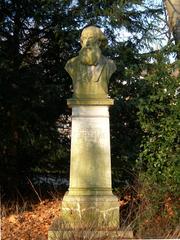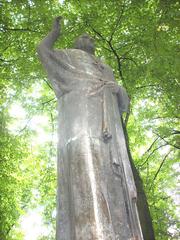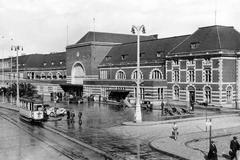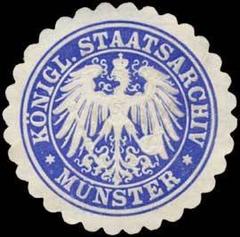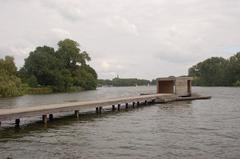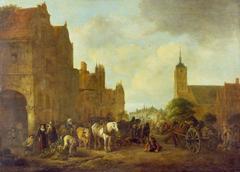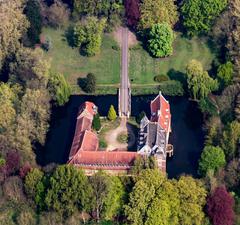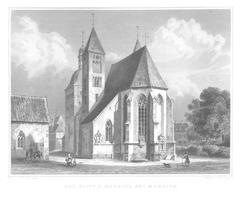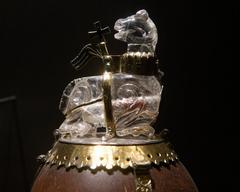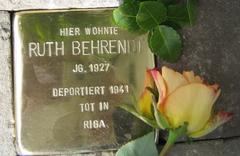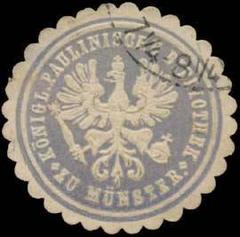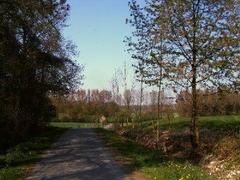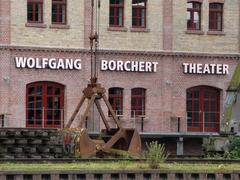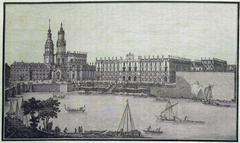Visiting the Domkammer of St. Paul’s Cathedral in Münster, Germany: Guide and Tips
Date: 14/06/2025
Introduction: The Domkammer’s Historical and Cultural Significance
Situated in Münster’s historic city center, the Domkammer of St. Paul’s Cathedral is renowned as one of Westphalia’s most significant ecclesiastical treasuries. Originating from the early 9th century with the Ludgerus-Dom, founded by Saint Ludger under Charlemagne, the Domkammer has evolved through periods of growth, turmoil, and renewal. Its collection includes medieval reliquaries, goldsmith masterpieces, and liturgical textiles, providing a unique insight into over a millennium of religious art and cultural heritage (Wikipedia - St.-Paulus-Dom; Cahiers de civilisation médiévale).
The Domkammer’s treasures—such as the 11th-century head reliquary of Saint Paul, Gothic silver-gilt statuettes, and richly embroidered vestments—reflect not only Münster’s spiritual devotion but also the city’s intertwined religious, artistic, and historical evolution. This guide offers a comprehensive overview of the Domkammer’s past and present, practical visitor information, and a look ahead to the upcoming Dommuseum PAULUS, which will ensure continued public access to Münster’s sacred and artistic legacy.
Contents
- Introduction: Why Visit the Domkammer?
- Historical Overview: The Evolution of the Domkammer
- Collection Highlights: Artifacts and Their Significance
- Practical Visitor Information: Hours, Tickets, Accessibility
- St. Paul’s Cathedral and Nearby Attractions
- The Transition: Domforum and Dommuseum PAULUS
- Frequently Asked Questions (FAQ)
- Conclusion & Recommendations
- References
Why Visit the Domkammer in Münster?
The Domkammer (Cathedral Treasury) of St. Paul’s Cathedral is a must-visit for anyone interested in medieval art, church history, and sacred heritage. Its collection represents a thousand years of craftsmanship, faith, and cultural continuity—making it a focal point for scholars, art lovers, and travelers seeking to understand Münster’s spiritual and artistic past.
Historical Overview: The Evolution of the Domkammer
Early Foundation and Growth
The origins of the Domkammer trace back to 805, following Charlemagne’s efforts to Christianize the region. Initially, sacred relics and treasures were stored close to the altar, in keeping with medieval tradition (Wikipedia - St.-Paulus-Dom). Over the centuries, gifts from bishops and nobility enriched the treasury, reinforcing the cathedral’s spiritual prestige and attracting pilgrims.
Artistic Flourishing (11th–16th Centuries)
As Münster became a major ecclesiastical center, the Domkammer expanded its collection to include exceptional reliquaries, goldsmith works, and textiles. The 11th-century head reliquary of Saint Paul stands out as the oldest surviving artifact of its kind (Medium - First Love and Mysteries). This period also saw the addition of Gothic silver-gilt statuettes and rare embroidered vestments.
Turbulence and Recovery (16th–19th Centuries)
The treasury survived periods of upheaval, including the Anabaptist reign, the Thirty Years’ War, and Napoleonic secularization (Medium - First Love and Mysteries). While some losses occurred, dedicated preservation ensured the survival of core treasures. The 19th century marked the beginning of systematic cataloging and documentation.
Modernization and Public Access (20th–21st Centuries)
Following World War II, the Domkammer was reestablished as a public museum, displaying over 700 artifacts across multiple floors (Stadt Münster: Domkammer). It became a vital center for appreciating Münster’s liturgical and artistic heritage.
Recent Developments
In 2017, the Domkammer closed to undergo major renovations and security upgrades (Museen in Münster). Its collection was safely stored or loaned to partner exhibitions. The building will reopen as the Domforum, a cultural and musical venue, while the treasures will be relocated to the new Dommuseum PAULUS in Münster’s Altstadt (Antenne Münster; Kirche+Leben).
Collection Highlights: Artifacts and Their Significance
- Medieval Reliquaries: The 11th-century head reliquary of Saint Paul and prophet busts (Philo and Hosea) exemplify Romanesque metalwork.
- Liturgical Textiles: Chasubles and altar cloths from the Romanesque to Baroque periods, including rare pieces still in liturgical use.
- Goldsmith Works: Chalices, monstrances, and processional crosses, reflecting evolving styles and techniques.
- Sculpture and Painted Panels: Gothic and Renaissance sculptures, notably the Baumberg group attributed to Johann Bradender.
- Ivories and Small Devotional Objects: Adding to the diversity of the collection.
These artifacts collectively present a vivid tapestry of Münster’s religious, artistic, and cultural development (Explorial - St. Paulus Dom; Cahiers de civilisation médiévale).
Practical Visitor Information
Current Status (2025)
- Domkammer: Closed for renovations and repurposing as Domforum (Museen in Münster).
- Dommuseum PAULUS: Scheduled to open in 2026 at Alten Steinweg, Altstadt. Will feature free admission and state-of-the-art exhibition facilities (Antenne Münster; Kirche+Leben).
- Interim Access: Many Domkammer treasures are on display at Diözesanmuseum Paderborn.
Visiting St. Paul’s Cathedral
- Address: Horsteberg 7-9, 48143 Münster, Germany (Google Maps)
- Hours: Open daily (hours vary; check official website).
- Admission: Cathedral entry is free; guided tours may carry a small fee.
- Facilities: Restrooms, souvenir shop, and information desk available.
- Accessibility: The cathedral and future museum are barrier-free.
Guided Tours & Events
- Cathedral Tours: Highlight history, art, and architecture (Domführungen - Paulusdom).
- Workshops: Available for groups and schools.
- Special Exhibitions: Occasional displays of Domkammer treasures in Münster and beyond.
Getting There
- By Public Transport: Accessible via bus and the main train station (Hauptbahnhof).
- By Car/Bike: Parking garages nearby; Münster is bike-friendly.
St. Paul’s Cathedral and Nearby Attractions
While the Domkammer is closed, visitors can explore:
- St. Paul’s Cathedral: Romanesque and Gothic architecture, 16th-century astronomical clock, and the tomb of Clemens August Graf von Galen.
- Prinzipalmarkt: Münster’s historic marketplace.
- Lambertikirche: Opposite the upcoming Dommuseum PAULUS.
- LWL Museum of Art and Culture: A short walk from the cathedral.
Combine your visit with the city’s vibrant weekly market on Domplatz and enjoy Münster’s renowned cycling routes.
The Transition: Domforum and Dommuseum PAULUS
- Domforum (Opening 2026): The former Domkammer building will become a multifunctional center for choir rehearsals, events, and community gatherings.
- Dommuseum PAULUS: The cathedral’s treasury will be displayed in a modern facility with free admission, interactive exhibits, and full accessibility in Münster’s city center (Kirche+Leben).
Frequently Asked Questions (FAQ)
Is the Domkammer open to visitors?
No, it is closed for renovations. Treasures can be viewed at Diözesanmuseum Paderborn or in select temporary exhibitions.
When will the Dommuseum PAULUS open?
Expected in 2026, with free admission.
Are guided tours available?
Yes, for St. Paul’s Cathedral and, upon opening, at Dommuseum PAULUS in several languages.
Is the cathedral and new museum accessible?
Yes, both are designed to be barrier-free.
Where can I find updates about reopening?
Check the official Domkammer website and St. Paul’s Cathedral.
Conclusion & Recommendations
The Domkammer of St. Paul’s Cathedral stands as a testament to Münster’s enduring spiritual and artistic heritage. While closed for renovation, its treasures remain accessible through special exhibitions and will soon be housed in the new Dommuseum PAULUS—a modern, inclusive museum in the city’s heart. Explore St. Paul’s Cathedral and Münster’s historic sites, and stay updated on the Domkammer’s exciting future by following official channels. For a richer experience, download the Audiala app for audio guides and local tips.
References
- Wikipedia - St.-Paulus-Dom (Münster)
- Medium - First Love and Mysteries
- Stadt Münster: Domkammer
- Explorial - St. Paulus Dom
- Cahiers de civilisation médiévale
- Museen in Münster
- Antenne Münster
- Kirche+Leben
- Diözesanmuseum Paderborn
- St. Paul’s Cathedral
